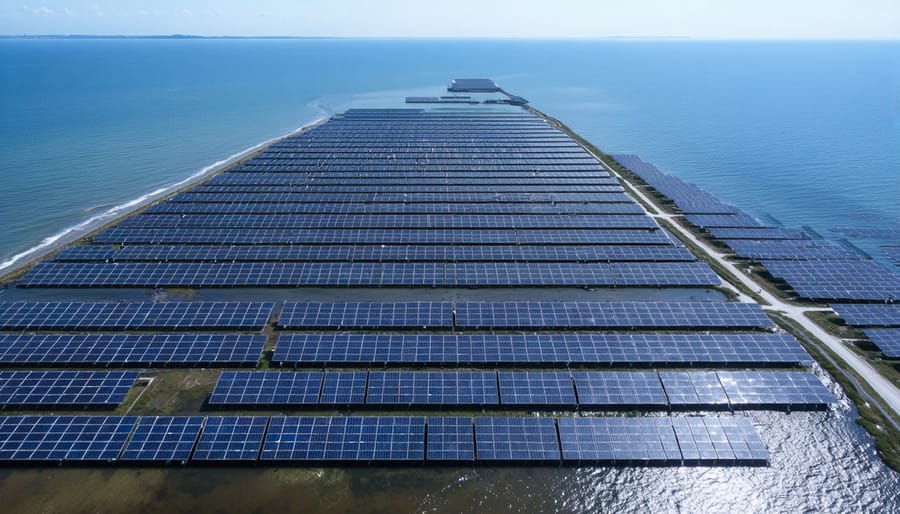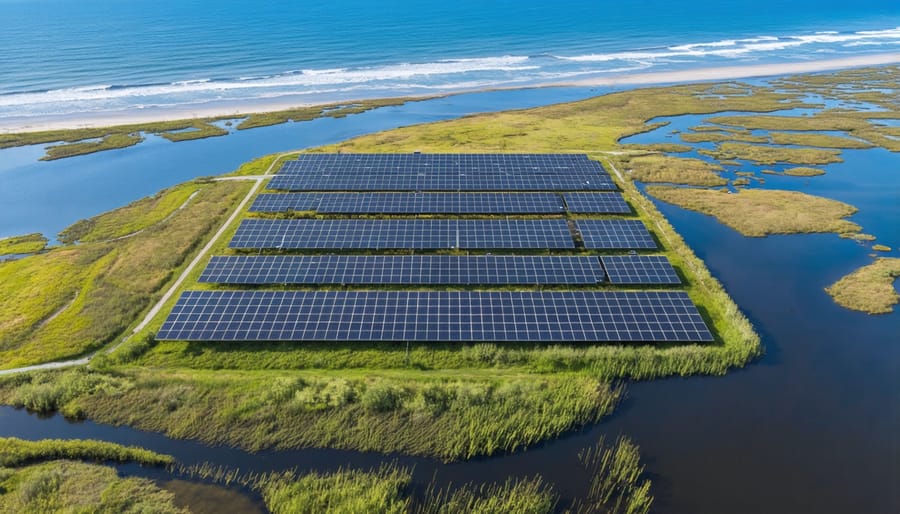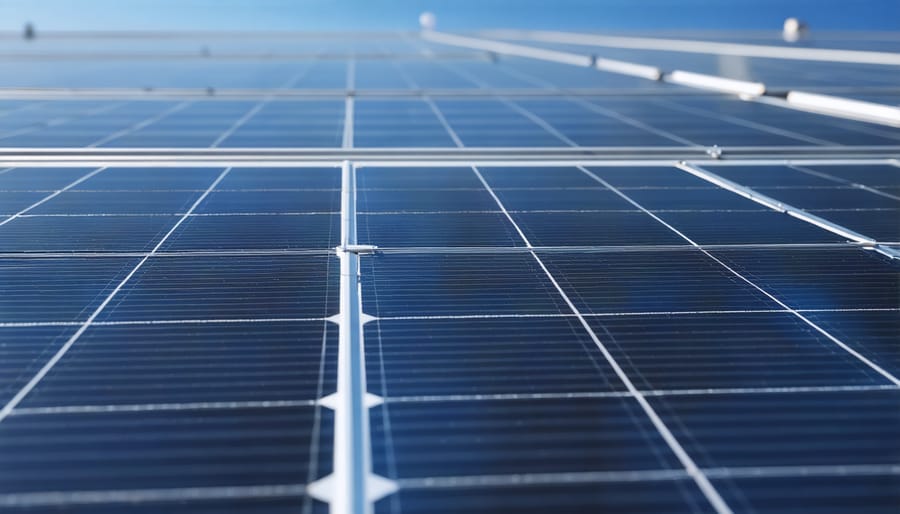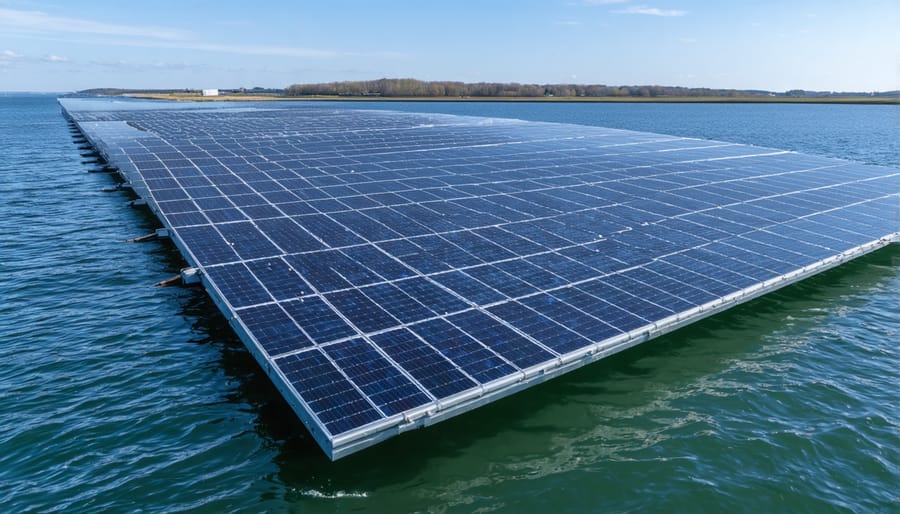Coastal Solar Power Is Revolutionizing Europe’s Wetland Energy Production

Coastal solar power installations are revolutionizing Europe’s renewable energy landscape, combining innovative maritime engineering with proven photovoltaic technology. Along Europe’s 68,000 kilometers of coastline, offshore solar innovations are transforming challenging marine environments into powerful energy generation zones. Salt-resistant solar panels, reinforced mounting systems, and specialized marine-grade components now enable unprecedented power generation in corrosive coastal conditions.
These advanced coastal installations deliver 15-20% higher energy yields compared to inland systems, capitalizing on intense solar reflection from water surfaces and cooler operating temperatures. From the North Sea’s floating solar arrays to Mediterranean coastal installations, these systems demonstrate remarkable resilience against harsh marine conditions while maintaining optimal performance.
For European coastal communities, this emerging technology represents a dual opportunity: addressing growing energy demands while utilizing previously untapped coastal spaces. Sophisticated monitoring systems and predictive maintenance protocols ensure these installations maintain peak efficiency despite challenging maritime conditions, marking a significant advancement in sustainable coastal development.
The Unique Potential of Coastal Solar Installations
Enhanced Solar Reflection from Water Bodies
Coastal waters offer a unique advantage for solar power generation through a phenomenon known as the albedo effect. When sunlight strikes water surfaces, they act as natural mirrors, reflecting significant amounts of solar radiation upward. This reflected light can reach nearby solar panels, effectively increasing their exposure to solar energy.
Research indicates that solar installations near water bodies can experience up to 15% higher energy yield compared to identical systems in non-coastal locations. This enhancement is particularly noticeable during morning and evening hours when the sun’s angle creates optimal reflection conditions. The smooth surface of calm waters provides consistent reflection, while gentle waves can actually increase the dispersal of reflected light, potentially benefiting panels across a wider area.
The effect is most pronounced within 100 meters of the waterline, making coastal zones prime locations for solar installations. This natural enhancement works particularly well in European coastal regions, where the combination of moderate temperatures and water reflection creates ideal conditions for solar power generation. Additionally, the cooling effect of sea breezes helps maintain optimal operating temperatures for the solar panels, further contributing to their efficiency.
Available Land Usage in Coastal Areas
Coastal regions present unique opportunities for solar power implementation, particularly as these areas often combine high solar irradiance with available land resources. Recent assessments of Europe’s solar potential indicate that coastal zones can effectively accommodate both ground-mounted and elevated solar installations while maintaining existing land uses.
Many coastal areas feature brownfield sites, former industrial zones, and unused port facilities that are ideal for solar development. These locations often already have essential infrastructure connections and are typically situated away from sensitive ecosystems. Innovative dual-use approaches have emerged, such as integrating solar panels with coastal protection structures, parking facilities, and recreational areas.
Agricultural land in coastal regions can benefit from agrivoltaic systems, where solar installations coexist with crop cultivation or grazing. This approach maximizes land efficiency while generating clean energy and maintaining food production. Furthermore, solar installations can be strategically positioned to protect coastal soils from erosion and salt spray, offering additional environmental benefits beyond renewable energy generation.

Engineering Solutions for Coastal Challenges
Corrosion-Resistant Technologies
In coastal environments, protecting solar installations from salt-induced corrosion is crucial for long-term performance and reliability. Modern corrosion-resistant technologies employ multiple layers of defence to shield solar components from aggressive marine conditions.
High-grade stainless steel frameworks, particularly marine-grade 316L steel, form the backbone of coastal solar installations. This material contains higher levels of molybdenum, offering superior resistance against chloride attack compared to standard steel variants.
Advanced coating systems provide additional protection for solar panel frames and mounting structures. Multi-layer protective coatings typically include:
– An anti-corrosive primer layer
– A zinc-rich intermediate coating
– A UV-resistant polyurethane topcoat
Innovative encapsulation technologies protect sensitive electronic components from salt spray exposure. Modern junction boxes and connectors feature IP68-rated waterproof seals and corrosion-resistant materials, ensuring continued functionality even in harsh coastal conditions.
Glass treatments have also evolved significantly, with hydrophobic nano-coatings that repel salt deposits and maintain optimal light transmission. These self-cleaning properties reduce maintenance requirements while preserving system efficiency.
For maximum protection, sacrificial anodes are often integrated into larger installations, drawing corrosive elements away from critical components. This technique, borrowed from marine engineering, significantly extends the lifespan of coastal solar installations.
Regular maintenance protocols, combined with these protective technologies, ensure coastal solar systems maintain peak performance throughout their operational life.

Flood-Proof Mounting Systems
In coastal environments, protecting solar installations from flooding requires specialized mounting solutions that combine durability with smart design. Elevated mounting systems raise solar panels significantly above ground level, typically 1-2 metres higher than standard installations, ensuring continued operation even during storm surges or extreme weather events.
Modern flood-proof mounting structures utilize marine-grade stainless steel and reinforced aluminum components, specifically engineered to withstand saltwater exposure and high-moisture environments. These systems feature enhanced structural support through deeper foundation anchoring and reinforced posts, designed to maintain stability during strong coastal winds and flooding scenarios.
The mounting hardware incorporates water-resistant junction boxes and elevated electrical components, keeping critical connections well above potential flood levels. Innovative quick-disconnect systems allow for rapid panel removal when extreme weather threatens, while maintaining robust electrical connections during normal operation.
Cable management systems are designed with water-resistant conduits and elevated cable trays to prevent water ingress and electrical failures. These systems include strategic drainage points and corrosion-resistant materials throughout the installation, ensuring longevity in challenging coastal conditions.
For maximum protection, advanced monitoring systems can be integrated into the mounting structure, providing real-time alerts about water levels and structural integrity. This proactive approach allows system owners to take preventive measures before flooding becomes critical, protecting their solar investment for the long term.
Environmental Integration and Conservation
Wetland Preservation Techniques
When installing solar infrastructure in coastal wetlands, preservation techniques play a crucial role in maintaining these delicate ecosystems. Leading European developers employ elevated mounting systems that minimize ground contact and preserve natural water flow patterns. These installations typically use helical piles or specialized foundation systems that reduce soil disruption while ensuring structural stability against coastal winds.
Buffer zones between solar arrays and sensitive habitat areas are carefully maintained, often incorporating native vegetation that supports local wildlife. Innovative cable management systems are suspended above the wetland surface, preventing interference with natural drainage patterns and protecting essential plant root systems.
Construction timing is strategically planned around wildlife breeding seasons and migration patterns, particularly for protected bird species common in European coastal areas. Specialized equipment with low ground pressure is used during installation to prevent soil compaction and protect delicate wetland vegetation.
Ongoing monitoring systems track environmental impact, while adaptive management strategies allow for adjustments based on ecological feedback. Many successful coastal solar projects incorporate wildlife corridors and maintain natural tidal flows, demonstrating that renewable energy generation can coexist with wetland conservation.
These preservation techniques have proven particularly effective along the North Sea coast, where several installations serve as model examples of sustainable energy development in sensitive coastal environments.
Dual-Use Applications
Coastal solar installations are increasingly demonstrating their potential for dual-purpose applications, combining clean energy generation with environmental conservation efforts. innovative water-based solar solutions are being integrated with coastal protection structures, creating multifunctional installations that serve both energy and ecological needs.
In the Netherlands, solar panels mounted on sea walls provide protection against rising sea levels while generating renewable energy. These installations incorporate wildlife corridors and nesting areas for coastal birds, demonstrating how solar infrastructure can enhance rather than compete with natural habitats.
Similar projects along the Mediterranean coast combine floating solar arrays with artificial reef structures, supporting marine biodiversity while producing clean energy. These installations create sheltered areas for fish populations and serve as anchoring points for coral restoration initiatives.
In Denmark, coastal solar facilities are being designed with integrated public spaces, including educational areas and viewing platforms. These spaces allow communities to engage with renewable energy technology while preserving access to coastal areas. The installations often incorporate native plant species and create microhabitats for local wildlife, proving that energy infrastructure can actively contribute to coastal ecosystem restoration.
European Success Stories
Netherlands Floating Solar Projects
The Netherlands continues to demonstrate remarkable innovation in coastal solar power, particularly through their groundbreaking floating solar installations. These projects showcase how Dutch engineering excellence combines with maritime energy integration to create sustainable power solutions in challenging environments.
One notable example is the Bomhofsplas floating solar park in Zwolle, which features 72,000 panels on specially designed flotation systems. The project’s innovative wave-resistant design ensures stability in harsh coastal conditions while maximizing energy yield. Dutch engineers incorporated sophisticated mooring systems that adapt to water level fluctuations, making these installations particularly resilient to North Sea weather patterns.
What sets Dutch floating solar projects apart is their dual-use approach. Many installations incorporate aquaculture and water quality monitoring systems, demonstrating how solar technology can coexist with marine ecosystems. The Oostvoornse Meer project, for instance, includes specialized light-permeable panels that allow marine life to thrive underneath while generating clean energy above.
These installations typically achieve 15-20% higher efficiency compared to land-based systems, thanks to the natural cooling effect of water and advanced bifacial panel technology. The success of these projects has established the Netherlands as a pioneer in coastal solar solutions, providing valuable insights for similar initiatives across Europe’s coastlines.

Mediterranean Coastal Installations
The Mediterranean coastline has become a prime location for innovative solar power installations, with several noteworthy projects demonstrating the potential of coastal solar energy. In Spain’s Costa del Sol, a pioneering floating solar array combines wave energy harvesting with photovoltaic panels, maximizing energy production while minimizing land use. This dual-purpose installation generates up to 15% more electricity compared to traditional inland solar farms, thanks to the cooling effect of sea breezes and reflected light from the water surface.
Greece’s Cyclades Islands showcase another successful approach, where solar installations are integrated into existing coastal infrastructure. On Paros, solar panels mounted on harbor walls and breakwaters generate power for port operations while protecting the structures from wave action. Similar installations in Croatia’s Dalmatian coast demonstrate how solar technology can be incorporated into maritime infrastructure without compromising aesthetic values or tourist appeal.
In southern France, the Port of Marseille-Fos has implemented an innovative solar canopy system that spans loading docks and parking areas, providing both shade and renewable energy. This installation generates 4.5 megawatts of power while protecting vehicles and cargo from intense Mediterranean sun. Italy’s Ligurian coast features several small-scale but highly effective installations that combine solar power with desalination systems, addressing both energy and water needs for coastal communities.
Coastal solar power stands at the forefront of Europe’s renewable energy evolution, offering a compelling solution for regions that combine abundant sunlight with unique environmental challenges. The growing success of coastal installations demonstrates that with proper planning and advanced technology, these areas can become powerhouses of clean energy production. As innovation in marine-grade materials and salt-resistant components continues to advance, the durability and efficiency of coastal solar installations will only improve.
The immediate benefits are already evident: reduced carbon emissions, decreased dependence on fossil fuels, and sustainable energy production that harmonises with coastal ecosystems. For European coastal communities, solar power installations represent not just an environmental choice, but a smart economic investment that promises long-term returns while contributing to regional sustainability goals.
Looking ahead, coastal solar power is poised to play a crucial role in Europe’s energy transition. With continuing technological improvements and increasing investment in coastal infrastructure, these installations will become more efficient and cost-effective. The future of coastal solar power is bright, offering a sustainable path forward for Europe’s energy needs while preserving our precious coastal environments for generations to come.
Leave a Reply